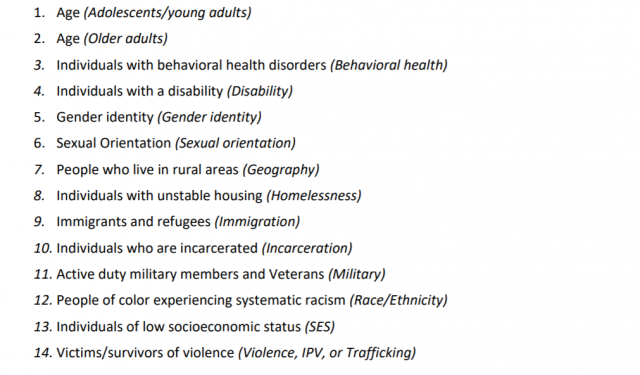A new report from the Governor’s Interagency Council on Health Disparities provides a literature review on disparities in access to reproductive healthcare, as well as the council’s detailed recommendations for Washington’s legislature to address them.
The council’s report is 117 pages long, includes research from 318 references alongside input from “key informants,” and details 14 populations “likely experiencing inequities in accessing reproductive health services,” for which it conducted separate literature reviews:

Part of the report also discusses intersectionality, explaining that the above 14 populations aren’t mutually exclusive.
“Multiple systems of oppression interact in the lives of those with multiple marginalized identities,” the report reads, “barriers in accessing reproductive health services may be compounded, furthering inequities to access.”
The council found that many of the 45 barriers to reproductive health care it identified are experienced by several populations. For example, 11 of the 14 populations may experience a barrier to accessing health insurance.

“While the ACA expanded health insurance opportunities and coverage for reproductive healthcare for many individuals, multiple populations continue to experience barriers in accessing reproductive health services,” according to the report.
The report prioritized recommendations that would “likely address access barriers” for multiple populations, and ultimately featured 14 total recommendations for Washington’s legislature.
“While not comprehensive, the recommendations represent actions that would reduce disparities in accessing reproductive healthcare for a number of individuals experiencing inequities in Washington State,” the report reads.
The recommendations (listed in-brief on pages 7 and 8 of the report, and in-depth starting on page 76) are broken into five categories: criminal justice, education, provider, health insurance, and state funding. All 14 lend the legislature specific advice.
One recommendation advises the legislature to replace federal Title X funding with state funding if Title X is cut at the federal level. Another recommendation advises the legislature to allocate state funds for the Department of Health to fund community-based organizations to “conduct age-appropriate, culturally-appropriate, comprehensive, medically accurate, and LGBTQIA-inclusive sexual health education” in community settings.
Other recommendations include:
- A slate of “opportunities for future research” for the legislature, agencies, or universities to consider pursuing;
- “Increasing the state Medicaid reimbursement rates for reproductive health services;”
- Granting authority to relevant agencies to include non-gendered language on forms;
- Developing a health insurance option for immigrants who are excluded from receiving Medicaid, such as undocumented immigrants; and
- Allocating state funds through the DOH for “community-based organizations to conduct age-appropriate, culturally-appropriate, comprehensive, medically accurate, and LGBTQIA-inclusive sexual health education in community settings.”
The report, issued January 1st, was mandated by Substitute Senate Bill 6219, which Governor Inslee signed into law last March. The bill made headlines last year for a couple of its other requirements: that Washington insurers must cover FDA-approved methods of contraception and voluntary sterilization without copayments or deductibles; and that if an insurer covers maternity care, it must also cover elective abortions.
This story was also published on our sister site, State of Reform.
Your support matters.
Public service journalism is important today as ever. If you get something from our coverage, please consider making a donation to support our work. Thanks for reading our stuff.











